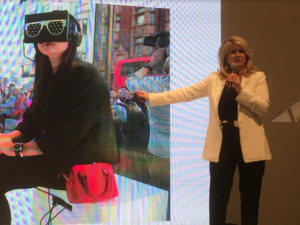Exclusives

Cisco Execs: AR and VR are Changing Retail
Story Highlights
NEW YORK — Augmented reality (AR) and virtual reality (VR) are already being used by retailers to enhance customer experience and those dealers that aren’t taking advantage of these nascent technologies yet should seriously consider jumping on the bandwagon, according to Cisco executives.
Some retailers don’t allow their store sales associates to use email or tablets, or even go online to check inventory, Amit Chetal, digital solutions lead at Cisco, said during an AR/VR panel discussion at the CE Week conference July 13. He classified that as a mistake. It’s important for retailers to instead “empower” their store associates by allowing them to make use of AR, VR and other technologies, and “get rid of that legacy thinking” that may be standing in the way of companies evolving and remaining competitive, he said.
By empowering store associates with all the new technological tools available, they will be able to better serve their customers and retailers will also be able to cut down on associate turnover, Chetal said. At the same time, “security is paramount” with whatever technologies companies decide to take advantage of, so that must be factored into their plans, he said.
It’s imperative for retailers to harness new digital technologies, even if they think that something like the mobile game “Pokemon Go” – which some retailers were able to capitalize on — will be just a short-term fad, Kathryn Howe, director of Retail Industry Digital Transformation-Americas at Cisco, said. It’s important for companies to “look at the disruption” to their businesses and not necessarily just “the disruptor,” she said. Retailers that were able to harness the popularity of “Pokemon Go” quickly did so because they “were ready” and “had security in place,” as well as Wi-Fi.
AR and VR represent the “fourth major computing platform,” following PCs, the Internet and mobile devices, Nathan Pettyjohn, founder of the VR/AR Association, said. He recommended that retailers “harness” these and other new technologies to their advantage because “it’s really easy to leverage what’s out there right now.” If they don’t do it now, he warned, “you’ll be left behind.”
Pettyjohn pointed to retailers including Lowe’s and Tommy Hilfiger that have already set up VR headset stations at their stores where consumers, in those two respective cases, can use the technology to see what a new kitchen will look like or feel like they’re at a fashion event where new clothes were unveiled.
 Although Google Glass failed, “the technology is getting there” for more successful AR glasses and eventually there is “going to be a very elegant pair of glasses” that are probably, at least initially, going to be powered by our smartphones and that we “won’t look ridiculous” wearing, Pettyjohn said.
Although Google Glass failed, “the technology is getting there” for more successful AR glasses and eventually there is “going to be a very elegant pair of glasses” that are probably, at least initially, going to be powered by our smartphones and that we “won’t look ridiculous” wearing, Pettyjohn said.
Store associates will be able to use those glasses to provide extra information about the products they are selling, he said. He also predicted we’ll “all have AR glasses on” in 5-10 years, and those glasses will “be able to detect millions of data points every second” as shoppers walk through stores, allowing them to receive product recommendations.
Tony Scherba, CEO and founder of San Francisco design and application development company Yeti, also urged retailers to “embrace change.” He stressed that this change “doesn’t have to be a dramatic change and can be a “step-by-step process.”
 VR was also touched on later in the day at the conference, during a session called “Get in the eSports Game,” where executives at Intel, distributor/wholesaler Ingram Micro and computer maker Micro-Star International (MSI) focused on the soaring popularity of eSports, but also pointed to the increasing popularity of VR.
VR was also touched on later in the day at the conference, during a session called “Get in the eSports Game,” where executives at Intel, distributor/wholesaler Ingram Micro and computer maker Micro-Star International (MSI) focused on the soaring popularity of eSports, but also pointed to the increasing popularity of VR.
“ESports has exceeded every projection” and “continues to grow,” Barry Heller, client platform specialist at Intel, said, noting that his company continues to heavily invest in eSports. In addition to sponsoring eSports competitions, Intel is “continually coming out with new technologies to really take advantage in this space,” he said, pointing to his company’s powerful new processors.
He predicted that “we’ll start to see a tipping point maybe within the next five to 10 years,” in which everybody knows about eSports and the competitors become household names. “It truly is a worldwide phenomenon” that is popular among males and females, he said.
Half a billion viewers will be watching eSports competitions live within the next three years, he predicted. Intel is also investing in VR, he said, predicting that technology will be a major factor in the gaming space as well.









